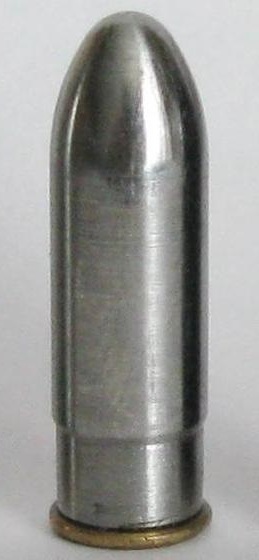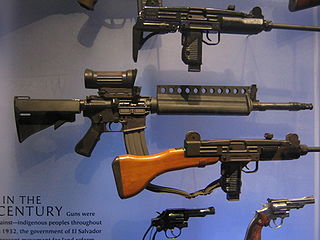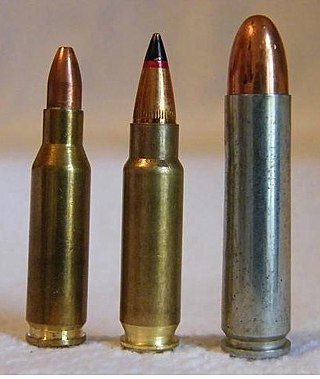
A firearm is any type of gun designed to be readily carried and used by an individual. The term is legally defined further in different countries.

Armour-piercing ammunition (AP) is a type of projectile designed to penetrate either body armour or vehicle armour.

A grenade launcher is a weapon that fires a specially designed, large-caliber projectile, often with an explosive, smoke, or gas warhead. Today, the term generally refers to a class of dedicated firearms firing unitary grenade cartridges. The most common type are man-portable, shoulder-fired weapons issued to individuals, although larger crew-served launchers are issued at higher levels of organization by military forces.

A shell, in a military context, is a projectile whose payload contains an explosive, incendiary, or other chemical filling. Originally it was called a bombshell, but "shell" has come to be unambiguous in a military context. Modern usage sometimes includes large solid kinetic projectiles that is properly termed shot. Solid shot may contain a pyrotechnic compound if a tracer or spotting charge is used.

The Heckler & Koch G11 is a non-production prototype assault rifle developed from the late 1960s–1980s by Gesellschaft für Hülsenlose Gewehrsysteme (GSHG), a conglomeration of companies headed by firearm manufacturer Heckler & Koch, Dynamit Nobel, and Hensoldt Wetzlar. The rifle is noted for its use of caseless ammunition.

Caseless ammunition (CL), or rather caseless cartridge, is a configuration of weapon-cartridge that eliminates the cartridge case that typically holds the primer, propellant and projectile together as a unit. Instead, the propellant and primer are fitted to the projectile in another way so that a cartridge case is not needed, for example inside or outside the projectile depending on configuration.

A sabot is a supportive device used in firearm/artillery ammunitions to fit/patch around a projectile, such as a bullet/slug or a flechette-like projectile, and keep it aligned in the center of the barrel when fired. It allows a narrower projectile with high sectional density to be fired through a barrel of much larger bore diameter with maximal accelerative transfer of kinetic energy. After leaving the muzzle, the sabot typically separates from the projectile in flight, diverting only a very small portion of the overall kinetic energy.

The Gyrojet is a family of unique firearms developed in the 1960s named for the method of gyroscopically stabilizing its projectiles. Rather than inert bullets, Gyrojets fire small rockets called Microjets which have little recoil and do not require a heavy barrel or chamber to resist the pressure of the combustion gases. Velocity on leaving the tube was very low, but increased to around 1,250 feet per second (380 m/s) at 30 feet (9.1 m). The result is a very lightweight and transportable weapon.

40 mm grenade is a generic class-name for grenade launcher ammunition in 40 mm (1.57 in) caliber. The generic name stems from the fact that several countries have developed or adopted grenade launchers in 40 mm caliber.
20 mm caliber is a specific size of popular autocannon ammunition. It is typically used to distinguish smaller-caliber weapons, commonly called "guns", from larger-caliber "cannons". All 20 mm cartridges have an outside projectile (bullet) diameter and barrel bore diameter of 0.787 inches (20.0 mm). These projectiles are typically 75 to 127 mm (3–5 in) long, cartridge cases are typically 75 to 152 mm (3–6 in) long, and most are shells, with an explosive payload and detonating fuze.
The Advanced Combat Rifle (ACR) was a United States Army program, started in 1986, to find a replacement for the M16 assault rifle. Under the stress of battle the average soldier with an M16 may shoot a target at 45 meters, but hit probability is reduced to one out of ten shots on target by 220 meters. Because of this, the ACR program was initiated in the late 1980s to create a weapon that could double the hit probability. The ACR program was preceded by older programs such as the Special Purpose Individual Weapon. The program ended in 1990 after an expenditure of approximately US$300 million.
The 5.45×39mm cartridge is a rimless bottlenecked intermediate cartridge. It was introduced into service in 1974 by the Soviet Union for use with the new AK-74. The 5.45×39mm gradually supplemented and then largely replaced the 7.62×39mm cartridge in Soviet and Warsaw Pact service as the primary military service rifle cartridge.

The Heckler & Koch HK CAWS is a prototype automatic shotgun—designed as a combat shotgun—co-produced by Heckler & Koch and Winchester/Olin during the 1980s. It was Heckler & Koch's entry into the U.S military's Close Assault Weapon System program.

The Colt ACR was Colt's entry in the U.S. DoD Advanced Combat Rifle program, which concluded with the result that none of the entrants achieved enough of an improvement over the M16 to be worth the cost.

The ASM-DT is a Russian folding-stock underwater firearm. It emerged in the 1990s.

The 7.5 cm KwK 40(7.5 cm Kampfwagenkanone 40) was a German 75 mm Second World War era vehicle-mounted gun, used as the primary armament of the German Panzer IV medium tank and the Sturmgeschütz III and Sturmgeschütz IV tank destroyers/assault guns.

Ammunition is the material fired, scattered, dropped, or detonated from any weapon or weapon system. Ammunition is both expendable weapons and the component parts of other weapons that create the effect on a target.

The PAPOP was a French project to construct a computerized infantry weapon for the FÉLIN system, capable of hitting hidden or protected targets. It would have combined a 35 mm grenade launcher with a 5.56×45mm NATO assault rifle, both in a bullpup configuration, complete with targeting aids and an unorthodox sight.

The 4.6×30mm cartridge is a small-caliber, high-velocity, smokeless powder, rebated rim, bottlenecked centerfire cartridge designed for personal defense weapons (PDW) developed by German armament manufacturer Heckler & Koch (HK) in 1999. It was designed primarily for the MP7 PDW to minimize weight and recoil while increasing penetration of body armor. It features a bottlenecked case and a pointed, steel-core, brass-jacketed bullet.

The 7.92×33mm Kurz is a rimless bottlenecked intermediate rifle cartridge developed in Nazi Germany prior to and during World War II, specifically intended for development of the Sturmgewehr 44. The ammunition is also referred to as 7.9mm Kurz, 7.9 Kurz, 7.9mmK, or 8×33 Polte. The round was developed as a compromise between the longer 7.92×57mm full-power rifle cartridge and the 9×19mm Parabellum pistol cartridge, and is the first mass-used intermediate cartridge in the world.
















